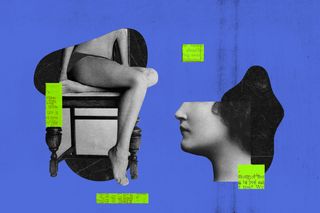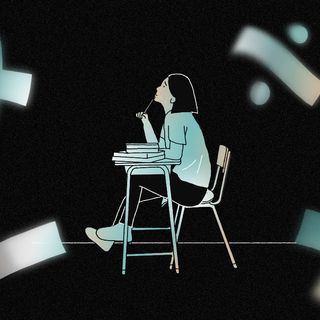
The Feminist Debate: Can Porn Ever Be Truly Feminist?
With industry dynamics so skewed against performers — especially marginalized ones — can feminism and porn ever be compatible?

In Feminist Debates, we pit feminist arguments about power, sex, work, and love against each other — and unpack the grey areas.
Last month, former porn star Lana Rhoades said that she was asexual, and wanted the porn industry to be banned.
Rhoades was one of the most well-known names in the business. Her proclamation cuts to the heart of the debate about porn: is there something fundamentally irredeemable about it, or can feminists reclaim it?
Feminist porn— or ethical porn, as some call it — has tried to answer this question. But arguably, it’s addressed parts of it: those that have to do with consent, fair compensation, and representation. Feminist porn, however, still exists in a niche: mainstream porn continues to dominate porn viewership globally, and streaming sites often carry content in which women’s consent is violated. The frightening thing? There’s no way to tell which ones those are. It’s why many former porn stars have begun to indict the industry as a whole — claiming that it’s coercive, exploitative, and ultimately damaging.
With porn consumption only growing, the question of ethical porn remains fraught within feminism. Porn is a visual medium — and everyone deserves to have access to sexual pleasure in this medium. But with industry dynamics so skewed against performers — especially marginalized ones — can feminism and porn ever be compatible? In India, this is an even more urgent question to grapple with. Porn is stigmatized; ethical porn is expensive to consume. Free porn sites remain the only point of access, but these sites also frequently feature rape videos, revenge porn, and other media containing non-consensual sex.
Rape culture is in the very foundation of porn. The male gaze exploits, objectifies women.
There’s seemingly no end in sight for the debate on whether porn is feminist or not. It goes back to the “sex wars” in the West – where anti-pornography feminists like Andrea Dworkin and Catherine MacKinnon denounced porn so much, they even found common cause with the conservative Reagan administration in the matter. The two drafted an ordinance that cast pornography as a civil rights violation, one that leads to violence against women. Its foundation is encapsulated by Robin Morgan’s polemic against the degradation of women in porn: “Pornography is the theory, and rape is the practice.” This frame of thought thinks of violence and porn as intertwined, in that the latter emerged as a media form that normalized the degradation of women for pleasure – and arguably, infused an otherwise safe culture of sex with violence and harm.
The flipside: anti-porn rhetoric criminalizes sexual minorities as “deviants.”
Many other feminists point out how porn-panic served as a vehicle for conservative fears around any kind of non-normative expressions of sexuality. Queer theorists like Gayle Rubin further argue: “A great deal of anti-porn propaganda implies sadomasochism is the underlying and essential ‘truth’ towards which all pornography tends. Porn is thought to lead to S/M porn which in turn is alleged to lead to rape.”
Related on The Swaddle:
Feminist Porn and the Glory of Ethical Sexual Representation
This then leads to an unpopular sexual minority being criminalized as deviant. The opposition to porn, then, is tied to a puritanical sexual morality rooted in heteronormative norms around procreation. This forecloses sex that’s free, pleasurable, and radical — all at once. Rubin pointed out that sometimes, feminist pronouncements uncomfortably aligned with conservative, even right-wing ideologies that further marginalized people. “We need to analyse and oppose the manifestations of gender inequality specific to the sex industry. But this is not the same as attempting to wipe out commercial sex,” they added.
But if performers say it’s exploitative, we should believe them.
Lana Rhoades isn’t the only performer to have spoken about the industry’s pitfalls. Mia Khalifa is another prominent example of someone who entered and exited porn with completely different expectations about what it would be like. Both women were paid abysmally low amounts compared to the profit they garnered for porn production companies and websites. Moreover, Mia Khalifa’s case adds another layer to the debate: the fetishization of minorities. As a Lebanese woman, Mia Khalifa shot to overnight success for a video in which she had sex while wearing a hijab. And this, in turn, opens up another conversation about the gaze with which porn is made: not just cis and male, but also white. This leads to racial stereotypes replicated and perpetuated in mainstream porn; one study found that “Black women were the targets of more acts of aggression than were White women, and Black men showed fewer intimate behaviors than did White men.”
The flipside: we should advocate for safe, consensual porn rather than banning porn outright.
Anti-porn arguments carry a flawed default assumption: that the predominant consumers of porn are men. But this isn’t true: people of all genders and sexualities not only consume porn, but also actively participate in making it. To argue that porn always dehumanizes marginalized people and perpetuates racist stereotypes is outdated. “Racism is a symptom of the bigger problem of society and porn no more contributes to that than any other form of commercial media,” saysSinnamon Love, a “multi-ethnic” porn performer.
Porn is influential, and harms people’s sex lives in real life.
“… pornography is a direct denial of the power of the erotic, for it represents the suppression of true feeling. Pornography emphasizes sensation without feeling,” wroteAudre Lorde, and the words speak to the heart of what makes porn such a feminist minefield. Its explicit purpose is to arouse viewers — but to do so with detachment. This is evident in the ways that people reported having sex in real life: influenced by the motions of porn, they were let down. Studies found that replaying “porn scripts” negatively affects young women’s sexual experiences.
The flipside: when made by feminists, porn can represent the diversity of sexual experiences
“As we saw it, the claim that ‘pornography is violence against women’ was code for the neo-Victorian idea that men want sex and women endure it,” said Ellen Willis. The influence of mainstream porn over people’s sex lives makes for an even more urgent need to create and mainstream ethical, feminist porn. And besides, the research on how it affects people is not only conflicting — it might be uncritical to assume that bad representations automatically disrupt a preexisting reality, where sex was better. As Drucilla Cornell said: “Without new images and new words in which to express our sexuality, we will be unable to create a new world for women.”
Rohitha Naraharisetty is a Senior Associate Editor at The Swaddle. She writes about the intersection of gender, caste, social movements, and pop culture. She can be found on Instagram at @rohitha_97 or on Twitter at @romimacaronii.
Related


What It’s Like To Live With: A Math Learning Disability
